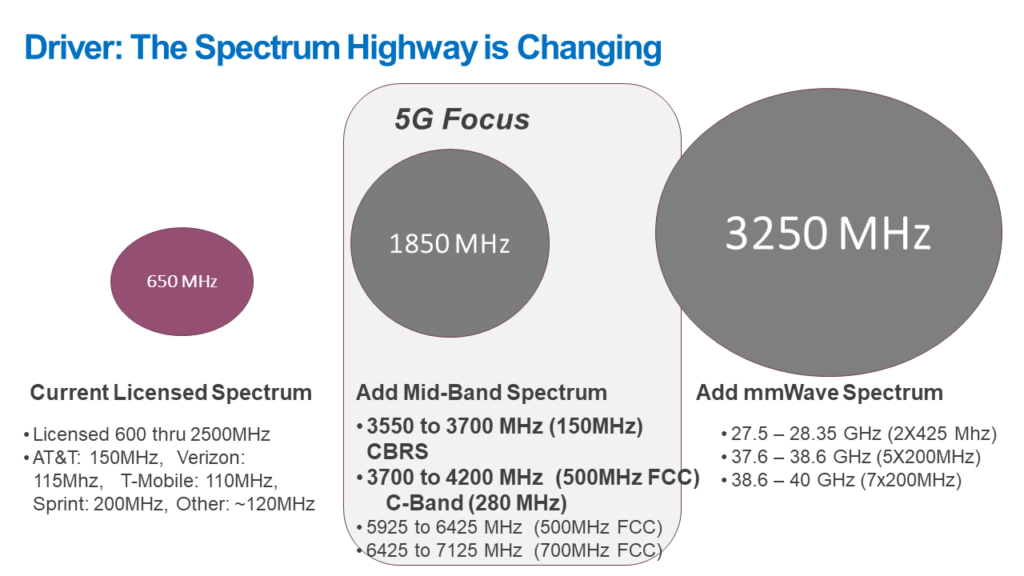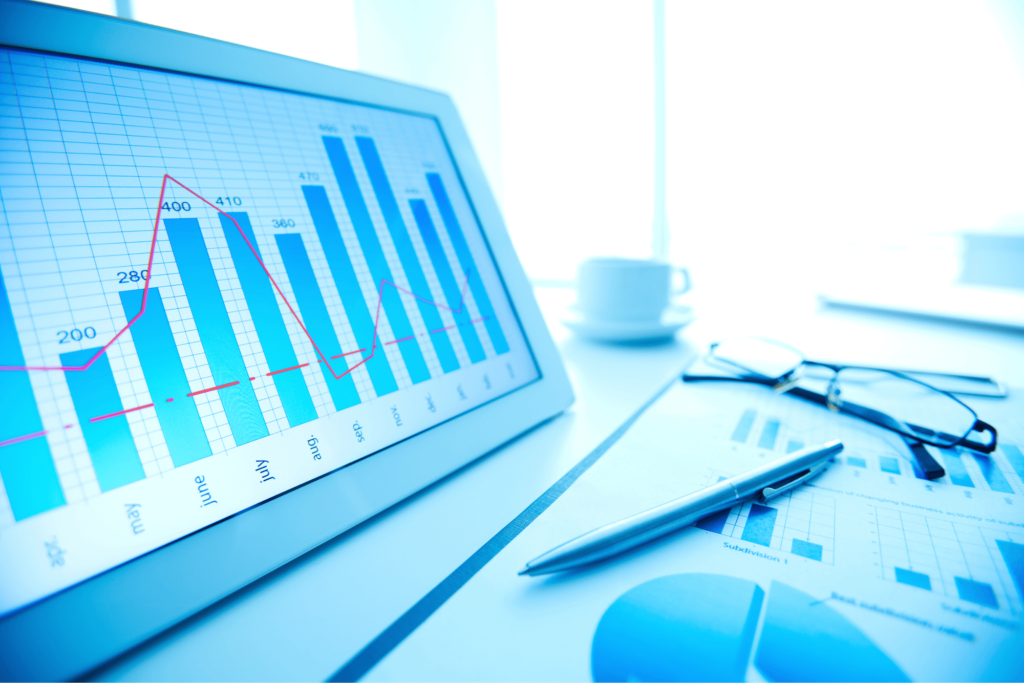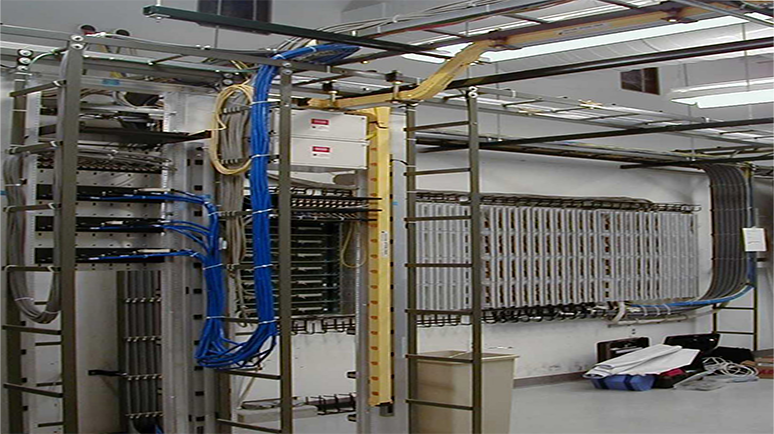August 23, 2022
After a long hiatus, your venue is now open. Everyone’s clamoring to get back in action. Congregate, socialize, and enjoy live events, whether at a concert hall, a stadium, a fairground, a zoo, a racetrack, or an arena. Large public venues where people want to use their devices to enhance the fan experience.
What are the driving factors as we think about wireless in large venues?

What do we need to consider for large public venues and wireless? First, the spectrum highway is changing. Where we are today is the purple dot, showing 650 megahertz of licensed spectrum that carriers own today. What’s happening very soon is on the right and the middle. In the middle is what we call the mid-band. Mid-band spectrum, a 5G focus for many carriers, starts as soon as either now or next year.
There is a new amount of spectrum that’s available for venue owners. This spectrum is known as the millimeter wave spectrum. If you listen to advertisements for 5G, that is what Verizon is behind. Millimeter wave is vital for sizeable public venue owners and managers to understand because that’s where it’s used. Whether it’s line-of-sight coverage, meaning millimeter wave does not penetrate through structures. There’s a considerable amount of spectrum with millimeter wave, which is relevant.
It’s not only about this massive amount of spectrum available but also how we use our devices, right? How we use our handheld devices. If you’re a venue owner or stadium manager, you think about how fans use their devices to get food, drink, and order. Social media, streaming, all these things. It’s essential to think of the fan experience and how the fan can use it. How to make it easy for them, make it fun. What do we need to control or manage that building has to operate? Things like building automation control, HVAC, ethernet, point of sale, and tracking assets. All these things.
As you go down the road of 5G, you will see better performance, increased speed, and lower latency. That’s important for things like virtual reality and gaming. You are going down to that one millisecond or, in that area, for a better user experience. And certainly a lot more capacity.
When thinking about large public venues, you know there are cellular and 5G. Yet, the reality is you have Wi-Fi with some flavor. Wi-Fi isn’t going anywhere. Wi-Fi is ubiquitous; it’s pervasive. People expect Wi-Fi in every building indoors, including concert halls and stadiums where they want to use that device to stay connected.
How can venue owners employ innovative financial models that reduce capital expenditures and lower overall costs?

Economics of DAS
The economics of a multi-carrier DAS, or simply a DAS, in most cases, the larger the venue, the more attractive you are to carriers. Nothing has changed in the past five years, considering how DAS is deployed in large venues. Carriers want to be there. Carriers cannot service your venue in most cases by the surrounding tower network. So, you need to create a system designed for 20,40,60, or 80,000 concurrent fans. This is what carriers are willing to contribute to the cost of DAS.
In most cases, if done correctly, it’s not overpriced, and carriers want to join. A multi-carrier system makes sense in most cases because it’s neutral, and all carriers can join. There’s an approach with a carrier-led DAS that can work as well. Understanding why carriers join is fundamental. Offload from the macro, engage the fan, and if one carrier is there, it pressures the others to join.
Economics of Private LTE or CBRS
CBRS is a new frequency. It’s a vast amount of spectrum. 150 megahertz of that spectrum is allocated into three classes – the incumbents or naval radar. This is the first shared network. The incumbents get it first. PAL or private licensed users who paid for this get it second. Then if you own a stadium, a fairground, or a racetrack, you fall in the category GAA. You can then build your private network or have a vendor make this for you.
There’s a lot of promise with CBRS. For one, it’s a vast amount of spectrum. LTE is inherently much more secure than Wi-Fi. That’s why many I.T. folks are interested in this. It remains to be seen if carriers are going to subsidize or join. This is the responsibility of the venue owner. Many of our customers are looking at this as a supplement to Wi-Fi. We’ve talked to customers looking at online gaming and thinking about security and all the implementations. So, indeed an exciting field.
Economics of Wi-Fi
Wi-Fi has gone from being a capital expense to having to come up with $1-$4 million to put in a high-density Wi-Fi seeing the idea of software as a service and Wi-Fi operating expense with many customers. “Hey, maybe I’ll have a hard time coming up with $2-$5 million, but I can come up with a predictable $12,000 a month”.
Furthermore, the idea of a long-term contract means that owners often like a 10-year schedule, with an upgrade built-in halfway through. So that’s gotten a lot of attention from venue owners. The ease of this and having to come up with this multi-million dollar capital for the Wi-Fi.
What is essential for infrastructure when we think about our venue?

Infrastructure is what you have and what you own as a venue owner. That can facilitate the installation of cable, WAPs, antennas, and supporting stuff.
There is a head-end, MDF room, or telco room. You want to place Wi-Fi private LTE, carrier, or DAS equipment in this room. Here is what you have as condition space with proper electrical circuits, the right HVAC, and the proper seismic bracing. Having this space ready and acceptable to meet carrier and vendor standards is essential.
The pathway is how you get cable and anything else from point A to point B. Can we use your cable trays or space? Do you have core holes through concrete that we can use to go from A to B? Can we neatly install J-hooks somewhere in the structure?
We’ve seen many venue owners, managers, and stakeholders design a multi-use fiber backbone that they have in place for anything. We’re putting in a lot more strands. Strands are relatively cheap compared to the actual cost of the cable and the installation. So, build as big as possible with the realization that future technologies will need things like Wi-Fi and DAS.
Lastly, when considering your venue, installing equipment, and driving that fan experience, you need to ensure that you have a grounding and bonding system, a system that is compliant with what’s called ANSI/TIA-607-B. In other words, how do you protect electrical equipment against damage? How do you protect the systems against life safety? Lightning strikes and other electrical disturbances. So, make sure the installation is code-compliant and safe.
What is analytics, and how can it be turned into a revenue center?

Analytics is the final frontier of networks and the holy grail. It’s what becomes the foundation for terms like monetization and ROI. How do we take what has traditionally been a cost center and turn it into a revenue center? Everything mentioned above is about the foundation of what the analytics platform rides on top. As a venue owner, it’s helpful to understand what your fans or attendees are looking for.
The definition of analytics is examining data sets and concluding. That is one of the most boring statements. Yet, in the context of monetization, ROI, or fan experience, analytics is the foundation for how you improve your physical environment. It’s the foundation for improving your operational environment and building on creating a robust fan experience. This is the first time in history that analytics will be a have-to-have. If you want to turn an analytics platform and the information gathered from a cost center into a revenue center, understanding the data and how to collect it will be imperative.
Owner-Operator Perspective
You’re a network, venue owner, or operator. You’re serving a tremendous number of fans. There are several different aspects that you must consider. You’ve got to look at providing a robust wireless network. Your fans are going to expect a ubiquitous network. One where they can almost do anything they can at home, they want to be able to do in your venue. Analytics can help optimize your network from a performance perspective and move toward a revenue center.
When deploying your platform, it’s all about trial and error. We’ve worked with customers and venues throughout the country. For these, the initial deployment focuses on venue optimization. Knowing where to place concession stands, digital signage, and team stores. The ability to understand what is happening in your environment is essential. Footfalls and dwell times help understand the flow through your environment. It helps you know where your fans are and what they’re doing. You can understand where to place signage better.
Consider a phased iterative approach to how you would lay out an analytics platform. You can look at it from the perspective of let’s optimize your network first. Let’s optimize your physical environment second. Finally, look at what is collected from your fans, how to get it, and how to use it. One important thing to remember is that once you have collected the data, it’s yours to utilize fully.
That is the big difference between DAS, cellular, and Wi-Fi. Off your Wi-Fi network, you own every piece of data collected by the analytics platform. The data can be used in a variety of ways. All this ties back to how you monetize what you’ve spent. Whether you are paying monthly or you’ve paid upfront in a capital expense. Those are the keys.
The Fan Experience
We’ve all been fans. We see events where there are many people a lot of the time. Now, assuming that the wireless environment is robust enough to create a situation where you can take your family of four. Your children can stream content from any device. Meaning you can pay attention to the game or event you are attending. That’s the typical family experience in the venue world nowadays.
Fans would also like to be able to traverse your environment in the easiest possible fashion. Keeping that in mind, you can better position everything. You can help create a better traffic flow – all within the environment using these analytics platforms.
Next is how you can begin interacting with those fans. This is a critical point where you transition. You go from revenue to a fan-based interaction revenue center. You can start collecting demographic data from their social media logins. These logins will allow you to communicate pre-game, in-game, and post-game to your fans. The ability to keep a constant cadence of communication with the people coming to your venue, simultaneously using customized data that will be delivered to each of these fans based on demographics collected by your platform.
Some things to keep in mind are how we make the initial contact. How do you create content by which to deliver to the user? You can do that by collecting fan feedback from surveys. You can use concessionaires and coupons to keep them interested in getting them to log in to your platform. One of the most critical pieces is to be able to interact with your fans pre- and post-event. This is the essential nature of being able to create a revenue stream. One that bases itself on the fan, only in the game environment. These platforms should be able to deliver these types of services to you.
The final piece is an in-venue immersive experience. It’s being able to create content that’s delivered to your jumbotron. Or content that’s delivered to your field side streaming LED screens, or whatever the situation may be. It can even go to static signage. You can provide the type of content you want when you want it. To whom you want it to and when.
The Ability of Analytics
You should be looking at the ability of your analytics platform. To deliver it to you in ways that are used to create a revenue center. There are quite a few ways to do that. The basics are creating splash page logos and SSID engagement with a particular third-party ad seller. Push content to the devices that have opted into your Wi-Fi network with their customized data.
These platforms should be able to deliver that to you. You can understand who’s cashed in a coupon and who clicked on and responded to a particular ad provided by a third-party ad provider. Your platform allows you to go to your third-party advertiser and create customized content. Then deliver it to the user the next time your event. You’ve been able to create a scenario where you’re communicating with your fans and your event attendees 24/7, 365 days a year. That’s what these platforms should be able to unlock for you.
For all you I.T. folks who have worked with analytics dashboards, it looks somewhat similar from a network performance perspective. There’s a lot of data that can be collected. An example is heat maps, user information, and demographic data. It can be customized and passed into different categories that can be used for many reasons. One may be simple network performance. Another key one is venue optimization. Then the third piece, what will you sell to third-party advertisers? What is valuable to them?
That’s where the demographic piece comes in and is valuable to you over the long haul. Step one, deploy the platform. Step two, through trial and tribulation, learn how to use it to optimize your venue performance. Step three, learn how to collect data and be able to sell that data. This is the critical jump-off point where you have gone from a high cost to a significant revenue center.
From a physical perspective, it’s crucial because this is usually where venues first deploy these platforms. This is where you become experts in utilizing footfalls and dwell times. Position A for digital signage may be $2,000 a month, and position B might be $20,000 a month based on footfall and dwell time. This allows you to give your third-party advertisers, whether they be a local dentist or a national provider like Budweiser. Of course, the budgets are very different.
You can facilitate both of those throughout your environment. You are utilizing the type of information that comes out of these platforms. So very robust. It’s important moving forward to understand your fans as much as possible. Also, understand how your environment is performing from a physical perspective.
As a venue owner-operator, consider the value of your data. Know that you can deliver for your ad providers. You can structure many packages they can buy off and determine what kind of assets they would get. Would it be a simple Wi-Fi splash page logo positioning? Or would they be up for a VIP experience? You want to be able to give them a package option generated by the analytics platform. In position A, they will get 5,000 views per event. In position B, they’re going to get 18,000 views. Different values go along with that. So, you start to see how analytics can be packaged into significant value for your third-party ad providers.
Next Steps & How to Connect
If you have any questions or want to reach out, visit us at www.connectivitywireless.com. We would love to try and help with anything you are trying to tackle and help answer any questions that you may have.
